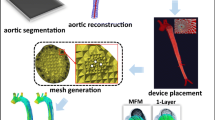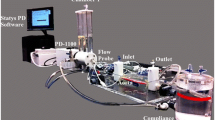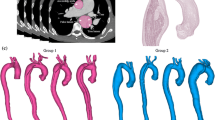Abstract
Understanding of the hemodynamics of Type B aortic dissection may improve outcomes by informing upon patient selection, device design, and deployment strategies. This project characterized changes to aortic hemodynamics as the result of dissection. We hypothesized that dissection would lead to elevated flow reversal and disrupted pulsatile flow patterns in the aorta that can be detected and quantified by non-invasive magnetic resonance imaging. Flexible, anatomic models of both normal aorta and dissected aorta, with a mobile intimal flap containing entry and exit tears, were perfused with a physiologic pulsatile waveform. Four-dimensional phase contrast magnetic resonance (4D PCMR) imaging was used to measure the hemodynamics. These images were processed to quantify pulsatile fluid velocities, flow rate, and flow reversal. Four-dimensional flow imaging in the dissected aorta revealed pockets of reverse flow and vortices primarily in the false lumen. The dissected aorta exhibited significantly greater flow reversal in the proximal-to-mid dissection as compared to normal (21.1 ± 3.8 vs. 1.98 ± 0.4%, p < 0.001). Pulsatility induced unsteady vortices and a pumping motion of the distal intimal flap corresponding to flow reversal. Summed true and false lumen flow rates in dissected models (4.0 ± 2.0 L/min) equaled normal flow rates (3.8 ± 0.1 L/min, p > 0.05), validated against external flow measurement. Pulsatile aortic hemodynamics in the presence of an anatomic, elastic dissection differed significantly from those of both steady flow through a dissection and pulsatile flow through a normal aorta. New hemodynamic features including flow reversal, large exit tear vortices, and pumping action of the mobile intimal flap, were observed. False lumen flow reversal would possess a time-averaged velocity close to stagnation, which may induce future thrombosis. Focal vortices may identify the location of tears that could be covered with a stent-graft. Future correlation of hemodynamics with outcomes may indicate which patients require earlier intervention.







Similar content being viewed by others
References
Ahrens, J., B. Geveci, and C. Law. ParaView: an end-user tool for large data visualization. In: Visualization Handbook, edited by C. D. Hansen, and C. R. Johnson. Cambridge: Academic Press, 2005, pp. 717–731.
Akutsu, K., J. Nejima, K. Kiuchi, K. Sasaki, M. Ochi, K. Tanaka, et al. Effects of the patent false lumen on the long-term outcome of type B acute aortic dissection. Eur. J. Cardiothorac. Surg. 26:359–366, 2004.
Alimohammadi, M., J. M. Sherwood, M. Karimpour, O. Agu, S. Balabani, and V. Diaz-Zuccarini. Aortic dissection simulation models for clinical support: fluid–structure interaction vs. rigid wall models. Biomed. Eng. Online 14:1–16, 2015.
Birjiniuk, J., J. M. Ruddy, E. Iffrig, T. S. Henry, B. G. Leshnower, J. N. Oshinski, et al. Development and testing of a silicone in vitro model of descending aortic dissection. J. Surg. Res. 198(2):502–507, 2015.
Cecchi, E., C. Giglioli, S. Valente, C. Lazzeri, G. F. Gensini, R. Abbate, et al. Role of hemodynamic shear stress in cardiovascular disease. Atherosclerosis 214(2):249–256, 2011.
“Characteristic Properties of Silicone Rubber Compounds.” Shin-Etsu Co. http://www.silicone.jp/e/catalog/pdf/rubber_e.pdf.
Chatzizisis, Y. S., A. H. Coskun, M. Jonas, E. R. Edelman, C. L. Feldman, and P. H. Stone. Role of endothelial shear stress in the natural history of coronary atherosclerosis and vascular remodeling. J. Am. Coll. Cardiol. 49(25):2379–2393, 2007.
Chen, D., M. Müller-Eschner, H. von Tengg-Kobligk, D. Barber, D. Böckler, R. Hose, et al. A patient-specific study of type-B aortic dissection: evaluation of true-false lumen blood exchange. Biomed. Eng. Online 12:1–16, 2013.
Cheng, Z., N. B. Wood, R. G. J. Gibbs, and X. Y. Xu. Geometric and flow features of type B aortic dissection: initial findings and comparison of medically treated and stented cases. Ann. Biomed. Eng. 43(1):177–189, 2015.
Chung, J. W., C. Elkins, T. Sakai, N. Kato, T. Vestring, C. P. Semba, et al. True-lumen collapse in aortic dissection: Part I. Evaluation of causative factors in phantoms with pulsatile flow. Radiology 214:87–98, 2000.
Clough, R. E., M. Waltham, D. Giese, P. R. Taylor, and T. Schaeffter. A new imaging method for assessment of aortic dissection using four-dimensional phase contrast magnetic resonance imaging. J. Vasc. Surg. 55(4):914–923, 2012.
Davies, P. F. Hemodynamic shear stress and the endothelium in cardiovascular pathophysiology. Nat. Clin. Pract. Cardiovasc. Med. 6(1):16–26, 2009.
Eggebrecht, H., U. Herold, O. Kuhnt, A. Schmermund, T. Bartel, S. Martini, et al. Endovascular stent-graft treatment of aortic dissection: determinants of post-interventional outcome. Eur. Heart J. 26(5):489–497, 2005.
François, C. J., M. Markl, M. L. Schiebler, E. Niespodzany, B. R. Landgraf, C. Schlensak, et al. Four-dimensional, flow-sensitive magnetic resonance imaging of blood flow patterns in thoracic aortic dissections. J. Thorac. Cardiovasc. Surg. 145(5):1359–1366, 2013.
Haskett, D., et al. Microstructural and biomechanical alterations of the human aorta as a function of age and location. Biomech. Model. Mechanobiol. 9(6):725–736, 2010.
Hwang, J., A. Saha, Y. C. Boo, G. P. Sorescu, J. S. McNally, S. M. Holland, et al. Oscillatory shear stress stimulates endothelial production of O2 − from p47phox-dependent NAD(P)H oxidases, leading to monocyte adhesion. J. Biol. Chem. 278(47):47291–47298, 2003.
Jackson, J. P. The growing complexity of platelet aggregation. Blood 109(12):5087–5095, 2007.
Karmonik, C., S. Partovi, M. Müller-Eschner, J. Bismuth, M. G. Davies, D. J. Shah, et al. Longitudinal computational fluid dynamics study of aneurysmal dilatation in a chronic DeBakey type III aortic dissection. J. Vasc. Surg. 56(1):260–263.e1, 2012.
Kilner, P. J., G. Z. Yang, R. H. Mohiaddin, D. N. Firmin, and D. B. Longmore. Helical and retrograde secondary flow patterns in the aortic arch studied by three-dimensional magnetic resonance velocity mapping. Circulation 88(5):2235–2247, 1993.
Ku, D. N., D. P. Giddens, C. K. Zarins, and S. Glagov. Pulsatile flow and atherosclerosis in the human carotid bifurcation. Positive correlation between plaque location and low oscillating shear stress. Arterioscler. Thromb. Vasc. Biol. 5(3):293–302, 1985.
LeMaire, S. A., and L. Russell. Epidemiology of thoracic aortic dissection. Nat. Rev. Cardiol. 8(2):103–113, 2011.
Lin, L. I. A concordance correlation coefficient to evaluate reproducibility. Biometrics 45(1):255–268, 1989.
Markl, M., A. Frydrychowicz, S. Kozerke, M. Hope, and O. Wieben. 4D Flow MRI. J. Magn. Reson. Imaging 36:1015–1036, 2012.
Mészáros, I., J. Mórocz, J. Szlávi, J. Schmidt, L. Tornóci, L. Nagy, et al. Epidemiology and clinicopathology of aortic dissection: a population-based longitudinal study over 27 years. Chest 117(5):1271–1278, 2000.
Mohr-Kahaly, S., R. Erbel, H. Rennollet, N. Wittlich, M. Drexler, H. Oelert, et al. Ambulatory follow-up of aortic dissection by transesophageal two-dimensional and color-coded Doppler echocardiography. Circulation 80(1):24–33, 1989.
Moore, J. E., C. Xu, S. Glagov, C. K. Zarins, and D. N. Ku. Fluid wall shear stress measurements in a model of the human abdominal aorta: oscillatory behavior and relationship to atherosclerosis. Atherosclerosis 110(2):225–240, 1994.
Nienaber, C. A., and R. E. Clough. Management of acute aortic dissection. Lancet 385:800–811, 2015.
Nienaber, C. A., S. Kische, H. Rousseau, H. Eggebrecht, T. C. Rehders, G. Kundt, et al. Endovascular repair of type B aortic dissection: long-term results of the randomized investigation of stent-grafts in aortic dissection trial. Circ. Cardiovasc. Interv. 6(4):407–416, 2013.
Nienaber, C. A., H. Rousseau, H. Eggebrecht, S. Kische, R. Fattori, T. C. Rehders, et al. Randomized comparison of strategies for type B aortic dissection: the Investigation of STEnt grafts in Aortic Dissection (INSTEAD) trial. Circulation 120:2519–2528, 2009.
Ranjan, V., Z. Xiao, and S. L. Diamond. Constitutive NOS expression in cultured endothelial cells is elevated by fluid shear stress. Am. J. Physiol. 269(2):H550–H555, 1995.
Rudenick, P. A., B. H. Bijnens, D. García-Dorado, and A. Evangelista. An in vitro phantom study on the influence of tear size and configuration on the hemodynamics of the lumina in chronic type B aortic dissections. J. Vasc. Surg. 57(2):464–474, 2013.
Rudenick, P. A., B. H. Bijnens, P. Segers, D. García-Dorado, and A. Evangelista. Assessment of wall elasticity variations on intraluminal haemodynamics in descending aortic dissections using a lumped-parameter model. PLoS ONE 10(4):e0124011, 2015.
Ruggeri, Z. M. Platelet adhesion under flow. Microcirculation 16:58–83, 2009.
Sorescu, G. P., M. Sykes, D. Weiss, M. O. Platt, A. Saha, J. Hwang, et al. Bone morphogenic protein 4 produced in endothelial cells by oscillatory shear stress stimulates an inflammatory response. J. Biol. Chem. 278(33):31128–31135, 2003.
Sueyoshi, E., I. Sakamoto, K. Hayashi, T. Yamaguchi, and T. Imada. Growth rate of aortic diameter in patients with Type B aortic dissection during the chronic phase. Circulation 110(Supplemental II):II256–II261, 2004.
Tanaka, A., M. Sakakibara, H. Ishii, R. Hayashida, Y. Jinno, S. Okumura, et al. Influence of the false lumen status on clinical outcomes in patients with acute type B aortic dissection. J. Vasc. Surg. 59(2):321–326, 2014.
Tsai, T. T., A. Evangelista, C. A. Nienaber, T. Myrmel, G. Meinhardt, J. V. Cooper, et al. Partial thrombosis of the false lumen in patients with acute type B aortic dissection. N. Engl. J. Med. 357(4):349–359, 2007.
Tsai, T. T., M. S. Schlicht, K. Khanafer, J. L. Bull, D. T. Valassis, D. M. Williams, et al. Tear size and location impacts false lumen pressure in an ex vivo model of chronic type B aortic dissection. J. Vasc. Surg. 47(4):844–851, 2008.
Tsai, T. T., S. Trimarchi, and C. A. Nienaber. Acute aortic dissection: perspectives from the International Registry of Acute Aortic Dissection (IRAD). Eur. J. Vasc. Endovasc. Surg. 37(2):149–159, 2009.
Vorp, D. A., et al. Wall strength and stiffness of aneurysmal and nonaneurysmal abdominal aorta. Ann. N. Y. Acad. Sci. 800:274–276, 1996.
Womersley, J. R. Method for the calculation of velocity, rate of flow and viscous drag in arteries when the pressure gradient is known. J. Physiol. 127:553–563, 1955.
Acknowledgments
We would like to acknowledge funding for this work from Medtronic, Inc.
Conflicts of Interest
Joav Birjiniuk has received a graduate research assistantship from Medtronic, Inc. Lucas Timmins declares that he has no conflict of interest. Mark Young is an employee of Medtronic, Inc. John Oshinski declares that he has no conflict of interest. David Ku declares that he has no conflict of interest. Ravi Veeraswamy has received consulting fees from Medtronic, Inc.
Ethical Approval
This article does not contain any studies with human participants or animals performed by any of the authors.
Funding
This study was funded by Medtronic, Inc. The following authors have received benefits for personal or professional use from a commercial party (Medtronic, Inc.) related directly to the subject matter of this manuscript: graduate research assistantship (J.B.), employment and salary (M.Y.), and consulting fees (R.K.V).
Author information
Authors and Affiliations
Corresponding author
Additional information
Associate Editors Francesco Migliavacca and Ajit P. Yoganathan oversaw the review of this article.
Electronic supplementary material
Below is the link to the electronic supplementary material.
13239_2017_312_MOESM1_ESM.tiff
Supplemental Figure 1 Pump driver voltage (top), central aortic pressure (middle), and model outlet flow rate (bottom) traces demonstrating physiologic pumping (TIFF 439 kb)
13239_2017_312_MOESM2_ESM.tiff
Supplemental Figure 2 Transverse motion of the intimal flap at different points in the cardiac cycle. Note accentuated motion of the intimal flap at the level of the exit tear (arrow) during fluid deceleration (TIFF 2093 kb)
13239_2017_312_MOESM3_ESM.tiff
Supplemental Figure 3 Pathline visualizations in both normal and dissected aortae. Physiological, helical flows can be noted throughout the aortic arch in both models, with significant skewing of velocity profile towards true lumen in the dissected case. Note filling of distal true lumen with cessation of flow partway down the false lumen (TIFF 5918 kb)
13239_2017_312_MOESM4_ESM.tiff
Supplemental Figure 4 Luminal flow rates in normal (black) and dissected (colored) aorta. Slice locations on right correspond to slices designated on left (asterisks indicate significant difference from the Normal aorta at all slices, p < 0.05) (TIFF 1392 kb)
Supplemental Video 1 Fluid flow reconstructed from PCMR data. Detail on right demonstrating diastolic vortex forming at exit tear (MP4 16570 kb)
Supplemental Video 2 Dye visualization of reversed false lumen flow and exit tear vortex formation in aortic dissection model (MOV 332517 kb)
Rights and permissions
About this article
Cite this article
Birjiniuk, J., Timmins, L.H., Young, M. et al. Pulsatile Flow Leads to Intimal Flap Motion and Flow Reversal in an In Vitro Model of Type B Aortic Dissection. Cardiovasc Eng Tech 8, 378–389 (2017). https://doi.org/10.1007/s13239-017-0312-3
Received:
Accepted:
Published:
Issue Date:
DOI: https://doi.org/10.1007/s13239-017-0312-3




